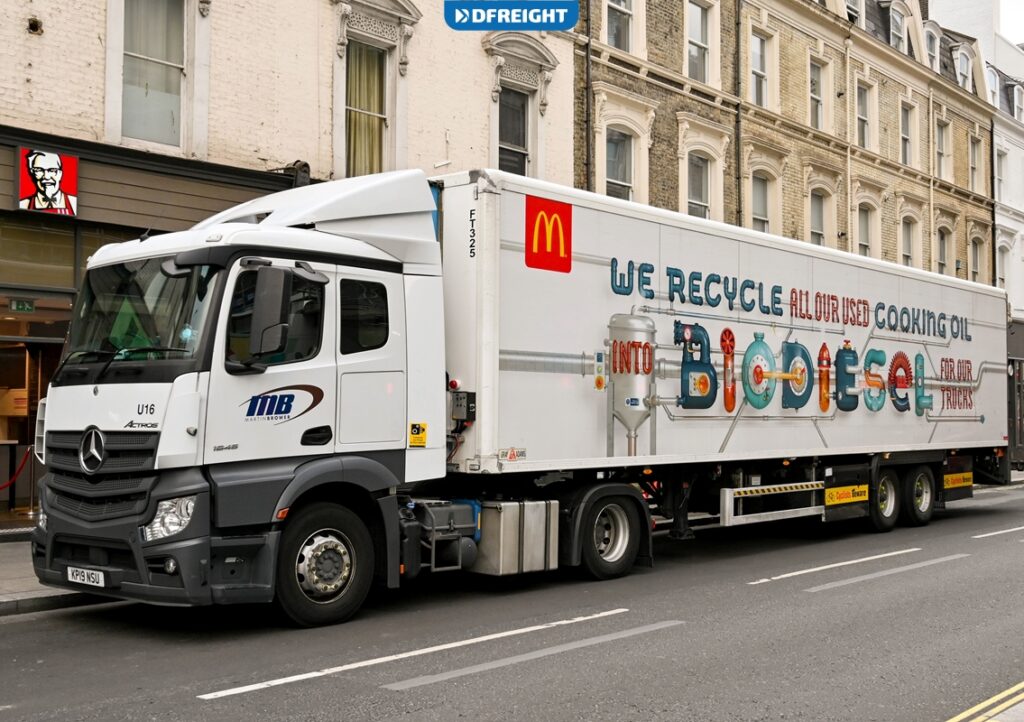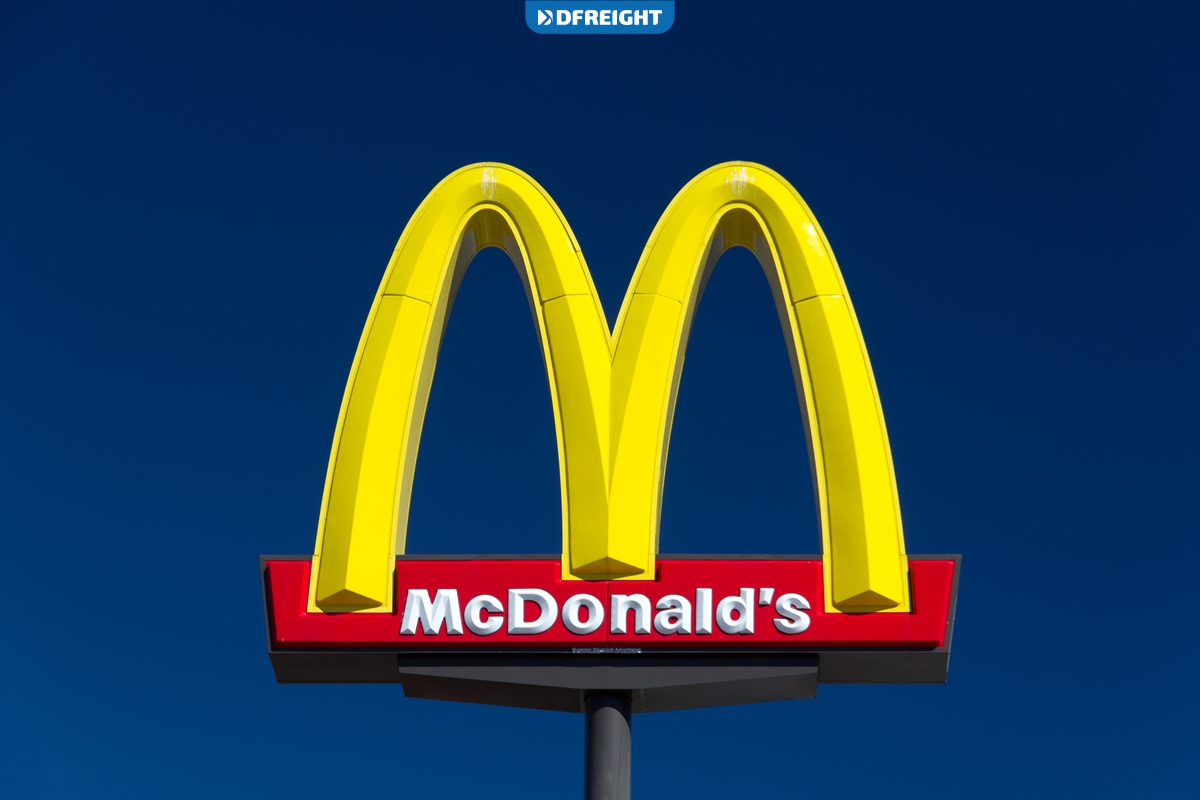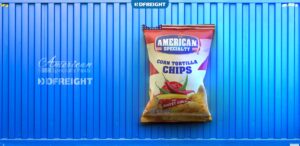The food supply chain is the process of getting food from producers to consumers, and it has evolved significantly in the digital age. McDonald’s is a significant player in the food supply chain, leveraging technology through its supply chain strategy to become highly efficient and stay competitive. Through partnerships with digital freight forwarders like DFreight, food companies can coordinate shipments, monitor performance, optimize resources, and monetize data analytics. With the help of digital forwarders, they have streamlined their food supply chain and improved their overall efficiency.
In this blog post, we will delve into the critical components of McDonald’s supply chain strategy and explore how it contributes to the company’s overall success.
Table of Contents
McDonald’s and Supply Chain Strategy
McDonald’s is one of the world’s largest fast-food chains, with a global presence and millions of customers served daily. Understanding its supply chain strategy is essential to comprehend the company’s ability to deliver quality food and maintain customer satisfaction consistently.
A well-designed supply chain strategy is crucial for any successful business, and McDonald’s is no exception. By effectively managing its supply chain, McDonald’s ensures the timely delivery of ingredients, minimizes costs, and maintains product consistency across its vast network of restaurants.
In the previous blogs, we looked into the supply chains of famous and leading companies, which you can read about each of them in the section below.
| Nestlé | KFC |
| Coca-Cola | Zara |
| Pepsi | Costco |
| Starbucks | Cisco |
| Amazon | H&M |
| Adidas | BMW |
| Samsung | L’Oréal |
| ADNOC | Honda |
| Nike | Tesla |
| Unilever | Intel |
| Schneider Electric | Apple |
| IKEA | Toyota |
| Walmart |
Navigating the Complexities of McDonald’s Supply Chain
McDonald’s is one of the world’s largest and most successful fast food companies, and a complex and far-reaching supply chain powers its success. From procurement and supplier management to distribution and logistics, technology and innovation to sustainability and ethical practices, and collaboration and partnerships – managing the complexities of its supply chain is no small feat. In the following, we look at the various elements of McDonald’s supply chain and explore how it ensures consistent success.
Procurement and Supplier Management
McDonalds offers a wide range of food products to customers around the world. The company is committed to selecting high-quality suppliers, setting a rigorous quality control and standards, and maintaining strong relationships with suppliers. By understanding their effective supplier management practices, we can gain insights into McDonalds’ commitment to providing excellent customer satisfaction.
1. Sourcing Ingredients and Products
McDonald’s sources a wide range of ingredients and products to create its diverse menu. The company carefully selects suppliers meeting stringent quality and safety standards, from fresh produce to meat, packaging, and condiments. McDonald’s manages its procurement process to ensure a steady supply of high-quality ingredients aligned with its brand values.
2. Supplier Selection and Evaluation
Maintaining strong relationships with suppliers is critical for McDonald’s supply chain. The company selects and evaluates its suppliers based on reliability, capacity, cost-effectiveness, and adherence to ethical practices. Discovering how McDonald’s fosters collaboration and transparency with its suppliers will shed light on its effective supplier management practices.
3. Quality Control and Standards
Ensuring consistent quality across all its restaurants worldwide is a priority for McDonald’s through the rigorous quality control measures implemented by the company, including regular inspections, audits, and certifications. Understanding how McDonald’s maintains high-quality standards will give insights into its commitment to customer satisfaction.
Distribution and Logistics
McDonald’s supreme success in the fast-food industry is due in part to its effective logistical operations. From centralized distribution models to inventory management and transportation strategies, McDonald’s has perfected its supply chain in order to meet customer demand, prevent stockouts, and maintain efficient delivery networks. By exploring how McDonald’s manages distribution and logistics, we can gain insights into their strategic prowess.
1. Centralized Distribution Model
Efficient distribution and logistics play a vital role in McDonald’s supply chain strategy. The company employs a centralized distribution model, allowing for streamlined operations and reduced costs. Understanding how McDonald’s manages the movement of ingredients and products from suppliers to restaurants will provide valuable insights into their logistical prowess.
2. Inventory Management
Maintaining optimal inventory levels is crucial for a fast-food chain like McDonald’s. McDonald’s utilizes advanced inventory management systems to forecast demand, prevent stockouts, and minimize waste. Discovering their inventory management techniques will showcase their ability to achieve operational efficiency and meet customer demand.
3. Transportation and Delivery
Ensuring timely and efficient transportation is essential to deliver fresh food to McDonald’s restaurants. The company manages transportation and delivery logistics, including using dedicated distribution centers, fleet optimization, and route planning. Understanding their transportation strategies will show their ability to operate on a global scale while maintaining consistency and quality.
Technology and Innovation
McDonald’s is renowned for its commitment to innovation and efficiency in its supply chain operations. By leveraging advanced digital solutions, automation technologies, and data analytics, the company is able to optimize their operations and ensure customer satisfaction at all stages of the supply chain.
1. Digital Supply Chain Solutions
In today’s digital age, technology plays a vital role in supply chain management. McDonald’s leverages digital solutions such as order management systems, real-time tracking, and data analytics to optimize their supply chain. Exploring their use of technology will highlight their commitment to innovation and efficiency.
2. Automation and Robotics
Automation and robotics have revolutionized supply chain operations across industries. McDonald’s is no exception, utilizing automation technologies in various supply chain stages. Automation and robotics enhance efficiency, reduce costs, and ensure food preparation and packaging consistency.
3. Data Analytics and Forecasting
Accurate demand forecasting is critical for McDonald’s to manage inventory, minimize waste, and meet customer expectations. The company utilizes data analytics, machine learning in logistics, and predictive modeling to forecast demand, optimize supply chain operations, and drive business growth. Understanding their data-driven approach will showcase their ability to adapt to changing consumer preferences.
Sustainability and Ethical Practices
McDonald’s has committed to sustainable sourcing, environmental impact reduction, and labor and social responsibility as core principles of its supply chain management strategy. These initiatives demonstrate the company’s commitment to protecting the environment and providing safe and ethical working conditions for those involved in their supply chain.
1. Sustainable Sourcing Initiatives
Sustainability is an increasingly important aspect of supply chain management, and McDonald’s recognizes the significance of minimizing its environmental footprint. The company’s sustainable sourcing initiatives include responsible agricultural practices, support for local farmers, and commitment to certified sustainable ingredients. Discovering McDonald’s efforts toward sustainability will highlight its dedication to protecting the planet.
2. Environmental Impact Reduction
McDonald’s understands the importance of reducing its environmental impact. The company implements measures to minimize waste generation, optimize packaging materials, and promote recycling and energy efficiency across its supply chain. Exploring their environmental initiatives will showcase their commitment to operating in an environmentally responsible manner.
3. Labor and Social Responsibility
McDonald’s supply chain strategy also focuses on labor and social responsibility. The company ensures fair and ethical treatment of workers throughout its supply chain, including supplier factories and farms. Understanding their commitment to labor rights and social responsibility will show their dedication to creating a positive impact beyond just business operations.

Collaboration and Partnerships
McDonald’s has built their successful supply chain on the basis of fostering strong collaborations and partnerships with franchisees, suppliers, stakeholders, and communities. From engaging stakeholders, to working closely with suppliers on production and demand, to working with franchisees to support their success, McDonald’s exemplifies an ideal model of successful collaboration and partnership.
1. Franchisee Relationships
McDonald’s operates on a franchise model, which requires strong collaboration and partnerships with its franchisees. The company fosters franchisee relationships, including supply chain collaboration, training programs, and shared goals. Exploring their collaborative approach will showcase the importance of a cohesive network in executing McDonald’s supply chain strategy.
2. Collaborative Planning with Suppliers
Collaborative planning with suppliers is crucial to McDonald’s supply chain strategy. The company works closely with suppliers to optimize production schedules, manage demand fluctuations, and drive continuous improvement. Understanding their collaborative planning processes will provide insights into their ability to adapt to market dynamics and ensure smooth operations.
3. Engaging Stakeholders
Engaging stakeholders is essential for the success of any supply chain strategy. McDonald’s recognizes the significance of fostering positive relationships with various stakeholders, including suppliers, customers, employees, and communities. The company actively engages stakeholders through transparent communication, social initiatives, and community partnerships. Discovering their stakeholder engagement practices will showcase their commitment to building strong relationships beyond the traditional supply chain.
Challenges and Future Trends
The global supply chain landscape is becoming increasingly complex as companies face new challenges due to changing consumer preferences, geopolitical risks, and technological advancements. McDonald’s is no exception to this complexity and has to navigate these issues while adapting their supply chain strategy to an ever-evolving market.
1. Global Supply Chain Complexity
Operating a global supply chain comes with its fair share of challenges. McDonald’s faces complexities, including managing diverse regulations, cultural differences, and geopolitical risks. The company tackles these challenges and adapts to the evolving global landscape.
2. Changing Consumer Preferences
Consumer preferences and trends constantly evolve, presenting challenges and opportunities for McDonald’s supply chain strategy. The company navigates changing consumer demands, including the rise of healthier food options, customization, and digitalization. Understanding their approach to consumer preferences will highlight their agility in adapting to market shifts.
3. Technological Advancements and Adaptation
The supply chain industry is experiencing rapid technological advancements. We will explore how McDonald’s embraces emerging technologies such as blockchain, the Internet of Things (IoT), and artificial intelligence (AI) to enhance their supply chain operations. Discovering their technological adaptations will showcase their ability to stay at the forefront of innovation.
Streamline Your Food Supply Chain with DFreight
Harness the power of digital freight forwarder DFreight and its online platform and mobile app to improve overall efficiency, reduce risk, and enhance traceability in your food supply chain. With DFreight, you can quickly access accurate and up-to-date product and shipment information to ensure your food deliveries arrive on time, every time. Unlock the potential of your food supply chain and take the hassle out of transporting food with DFreight today.

What factors should I consider when selecting a food provider for my supply chain?
When selecting a food provider for your supply chain, you should consider the provider’s quality standards, sustainability practices, transportation capabilities, pricing, customer service and availability. Additionally, be sure to evaluate their ability to meet your order requirements in a timely manner.
How can I improve the efficiency of my food supply chain?
You can improve the efficiency of your food supply chain by leveraging digital freight forwarding services to streamline the ordering and delivery process, monitor transportation processes, track inventories, and forge partnerships with suppliers for better food availability. Additionally, digital freight forwarding enables businesses to access lower-cost, more reliable transport options while optimizing supply chain visibility and control.
How is McDonald’s supply chain structured?
At the top of McDonald’s supply chain is an international network of strategic partnerships with various suppliers that are responsible for providing raw ingredients such as beef, potatoes, and eggs, as well as other finished products. Products are typically sent to McDonald’s regional distribution centers, which then send the products to franchised locations.
How does McDonald’s ensure food safety in their supply chain?
McDonald’s ensures food safety in its supply chain by evaluating food vendors and partners, maintaining strict food safety protocols and testing, and conducting regular quality and safety inspections. Additionally, the company has a traceability system to guarantee accountability and transparency when sourcing, manufacturing, and preparing foods.
What steps has McDonald’s taken to improve its supply chain strategy?
McDonald’s has taken a number of steps to improve its supply chain strategy, including expanding its use of third-party logistics providers, implementing automated ordering and delivery systems, partnering with suppliers to reduce waste, and leveraging new technologies to optimize operations.














